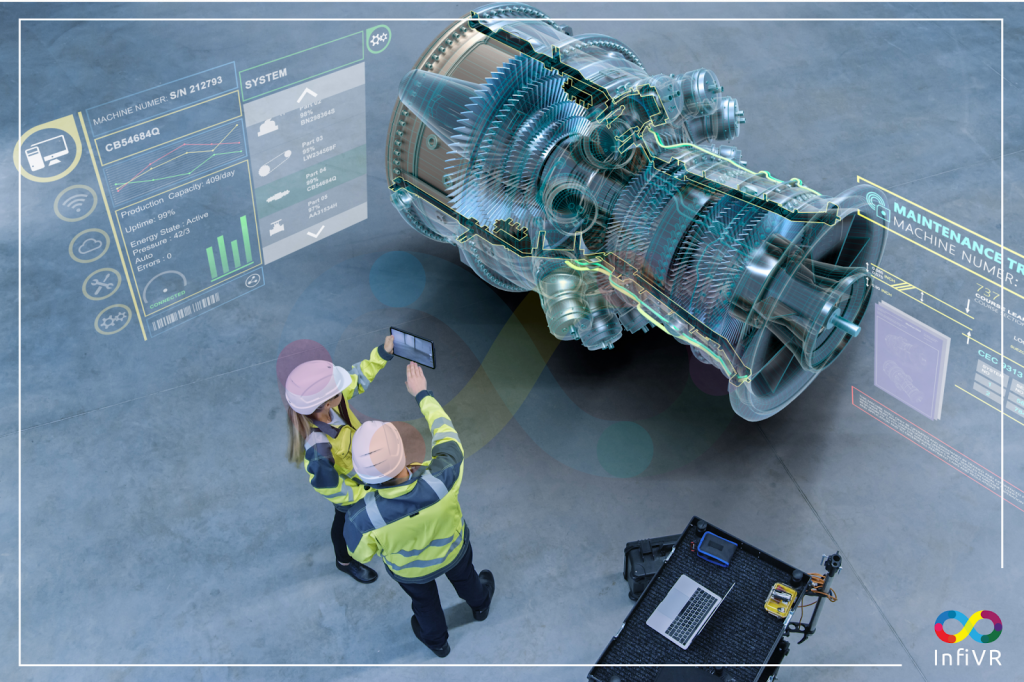Methods of Assessing Virtual Reality Training : Aviation Industry
In this section, we’ll delve into the diverse methods of assessing Virtual Reality (VR) training across various high-demand industries. Additionally, we’ll explore how this immersive technology is revolutionizing employee training and development, thereby increasing safety, boosting efficiency, and streamlining operations.
1. Aviation Industry
The advent of Virtual Reality (VR) and Augmented Reality (AR) has heralded a new era in aviation training, transforming traditional practices into immersive, real-time experiences. Moreover, this section dives deep into the various methods for assessing VR training within the aviation industry, outlining its application across diverse facets from flight deck procedures to maintenance activities, and pre-flight inspections.

1.1 Flight Deck Training Revolutionized by VR
For pilots and flight engineers, understanding how to react swiftly and appropriately during emergencies is paramount. VR provides these professionals with a safe, controlled environment to simulate diverse scenarios. Through this immersive platform, they can practice communication, decision-making, and emergency handling without real-world risk, leading to safer skies. The efficacy of these training methods can be evaluated by improved pilot response times, decision-making accuracy, and post-training assessments.
1.2 Maintenance Activities and VR: A Hands-on Approach
Another crucial application of VR in aviation training lies in aircraft maintenance. With VR and AR, aviation engineers can virtually interact with complex aircraft components, running simulations of various repair procedures. This hands-on virtual approach boosts their understanding, allowing them to learn proper maintenance techniques effectively. Assessment of this training can be made by observing a reduction in repair time, fewer mistakes, and an overall increase in operational efficiency.
1.3 Pre-Flight Inspections Made Efficient with VR
Pre-flight inspections are a vital component to ensure a safe flight, involving various personnel from ground crew to flight attendants. By using VR, these individuals can practice and perfect their inspection procedures without requiring an actual aircraft, thereby improving efficiencies. The effectiveness of such training is evident in the reduction of pre-flight inspection times and enhanced adherence to safety protocols.
1.4 Impact of VR on Training Effectiveness
The integration of VR into aviation training has proven significantly effective, as demonstrated by leading aeronautical universities and studies. For example, the use of VR training has reduced the time before a student pilot can fly solo by 30%. Additionally, research from Price Waterhouse Cooper shows that VR learners master content four times faster than in traditional classroom settings, further substantiating the impact of this technology.
Explore more about Virtual Reality Training with InfiVR:
At InfiVR, we redefine industrial training with virtual reality simulation and immersive 3D gamification experience. Furthermore, InfiVR is proud partners to many Fortune 500 companies, and we’re here to transform your next-generation training visions into reality. Let’s collaborate to elevate your business by training! If you want to know more, get in touch with our consultation experts at hello@InfiVR.com.
Want to know more:
- What is Virtual Reality?
- What is Virtual Reality Training?
- What is VR Simulation?
- Advantages of Virtual Reality Training?
- Applications of Virtual Reality Training.
- Virtual Reality Maintenance Training.
- Virtual Reality Inspection Training.
- Virtual Reality Operational Training.
- Virtual Reality Assembly Training
- Virtual Reality Support & Servicing Training
- Various types of Virtual Reality Training Mediums.
- Virtual Reality based Experiential Training
- Operational Virtual Reality Training
- Virtual Reality based Behavioral Training
- Different Types of Environments in VR Training – 3D Virtual Environment.
- Mixed Reality Virtual Environment.
- Spatial Virtual Environment.
- 360* Photography-based Virtual Environment.
- VR Training in the Aviation Industry.
- VR Training in the Aerospace Industry.
- VR Training in the Defence Industry.
- VR Training in the Oil & Gas Industry.
- VRTraining in the Warehouse Industry.
- VR Training in the Manufacturing Industry.
- Hardware Selections for Virtual Reality Training
- How to adopt virtual reality training for your company?
- How to look for a suitable partner for Virtual Reality Training development?
- How to develop Virtual Reality Training POC?
- How to assess the effectiveness and advantages of Virtual Reality Training POC implemented?
- How to develop Virtual Reality Training for full-scale implementation?
- Survey forms for feedback capture on VRT
- How to successfully draft a VR training RFP?